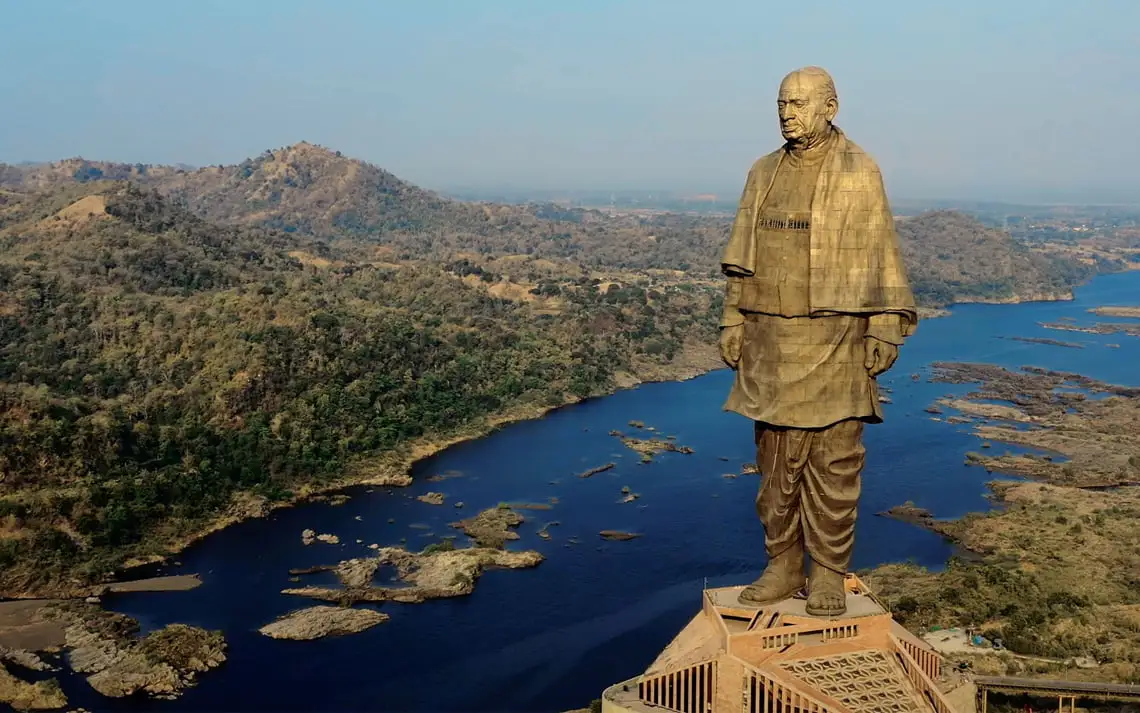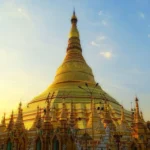
Standing proudly on the banks of the Narmada River in Gujarat, India, the Statue of Unity has captured the world’s attention as the tallest statue on the globe. Dedicated to Sardar Vallabhbhai Patel, revered as the “Iron Man of India,” this monumental structure symbolizes unity, strength, and the rich cultural heritage of India. With its impressive height and intricate design, the statue serves as a poignant tribute to Patel’s pivotal role in shaping modern India and continues to attract millions of visitors from around the world. Here, we explore 25 fascinating facts about the Statue of Unity, shedding light on its construction, significance, and impact as a global landmark.
Towering Titan: The Statue of Unity, located in the Indian state of Gujarat, stands at a staggering 597 feet (182 meters) tall, making it the tallest statue in the world. It surpasses China’s Spring Temple Buddha, which stands at 420 feet (128 meters), by over 170 feet (51 meters). This towering figure was constructed to honor Sardar Vallabhbhai Patel, a key figure in India’s history. The statue’s immense height symbolizes Patel’s monumental contributions to the nation’s unity and independence. Its colossal stature can be seen from miles away, becoming a significant landmark and a point of national pride.
Iron Man Inspiration: The statue immortalizes Sardar Vallabhbhai Patel, often referred to as the “Iron Man of India.” Patel was instrumental in the political integration of India after its independence in 1947, merging over 500 princely states into the Indian Union. His leadership and determination in achieving this difficult task earned him the nickname. The statue’s design, portraying Patel in a dignified walking posture, reflects his enduring legacy and unwavering commitment to national unity and governance.
Record-Breaking Build: Construction of the Statue of Unity began on October 31, 2013, and was completed in just 33 months, a remarkable feat of engineering and planning. This rapid construction was achieved through meticulous project management and the collaboration of thousands of workers, engineers, and architects. The project involved sophisticated techniques and technologies, including 3D scanning and computer simulations, to ensure precision and stability. The swift completion of such a massive structure is a testament to modern engineering capabilities and effective project execution.
Material Marvel: The construction of the Statue of Unity utilized over 1,500 tonnes of bronze and 18,500 tonnes of steel, making it an engineering marvel. The statue’s core is reinforced with a robust steel framework, ensuring structural integrity. The bronze cladding, which covers the exterior, gives the statue its distinctive appearance and durability. These materials were chosen not only for their strength but also for their ability to withstand the harsh environmental conditions of the region, including high winds and seismic activity.
Designed for Durability: The statue’s bronze cladding is designed to withstand wind speeds of up to 250 km/h (155 mph) and earthquakes measuring up to 6.5 on the Richter scale. This resilience is achieved through advanced engineering techniques and materials that provide both flexibility and strength. The statue’s foundation is anchored deep into the ground to ensure stability, while the internal structure allows for slight movements to absorb shocks from natural forces. These features ensure the statue’s longevity, preserving its grandeur for future generations.
Panoramic Paradise: The Statue of Unity features a viewing gallery located within its chest, offering breathtaking 360-degree views of the surrounding Narmada Valley. Positioned at a height of 500 feet (152 meters), the gallery allows visitors to enjoy stunning vistas of the Sardar Sarovar Dam, the Satpura and Vindhya mountain ranges, and the expansive countryside. This vantage point not only provides a unique perspective of the landscape but also enhances the visitor experience, making the statue a must-visit destination for tourists.
Green Giant: The project incorporated several eco-friendly measures, including a solar power plant that generates a portion of the statue’s electricity needs. This emphasis on sustainability reflects a commitment to minimizing the environmental impact of the monument. The use of renewable energy sources reduces the carbon footprint and sets an example for future infrastructure projects. Additionally, efforts to maintain green spaces and promote biodiversity around the statue contribute to the conservation of the local ecosystem.
Museum in the Base: The base of the Statue of Unity houses a museum dedicated to showcasing the life and achievements of Sardar Vallabhbhai Patel. This museum features a range of exhibits, including photographs, documents, and artifacts that highlight Patel’s pivotal role in India’s history. Interactive displays and multimedia presentations provide an engaging and educational experience for visitors. The museum serves not only as a tribute to Patel but also as an informative resource, educating the public about his contributions and the broader context of India’s independence and unification.
Lighting Up the Night: The statue is illuminated at night with a spectacular LED lighting system that brings the monument to life in various colors. This dynamic lighting enhances the statue’s visual appeal, making it a striking sight against the night sky. The LED system is programmed to create different lighting effects, highlighting the statue’s features and creating a mesmerizing display. The nightly illumination attracts visitors and adds to the statue’s grandeur, making it a focal point of nighttime activities in the region.
Costly Creation: The total cost of building the Statue of Unity is estimated to be around $300 million, making it one of the most expensive statues ever constructed. This substantial investment covered various aspects of the project, including design, materials, labor, and infrastructure development. Funding for the statue came from both public and private sources, reflecting the broad support for commemorating Sardar Vallabhbhai Patel. The significant financial outlay underscores the importance placed on the statue as a symbol of national pride and unity.
Record-Breaking Visitors: The Statue of Unity attracted over 2.8 million visitors in its first year, underscoring its popularity as a tourist destination. This impressive visitor count reflects the statue’s significant cultural and historical appeal. Tourists from all over India and the world come to witness the grandeur of the tallest statue, boosting local tourism and economy. The site’s comprehensive visitor amenities, including guided tours, viewing galleries, and educational exhibits, enhance the overall experience, making it a key attraction.
Symbolic Significance: The statue’s location on the banks of the Narmada River holds special significance as the river is considered sacred in Hinduism. This positioning ties the monument to India’s spiritual heritage, adding another layer of meaning to its already profound historical and cultural significance. The Narmada River’s importance in religious rituals and traditions elevates the statue’s status as a pilgrimage site, attracting not just tourists but also devotees who wish to pay their respects in a spiritually significant setting.
Controversial Construction: The construction of the Statue of Unity faced criticism for its environmental impact and the displacement of local communities. Environmentalists raised concerns about the potential damage to the nearby ecosystems, while local tribes expressed opposition to being relocated. These controversies sparked debates about the balance between development and conservation, as well as the ethical considerations of large-scale infrastructure projects. Despite these challenges, efforts were made to address environmental and social issues, though the controversy remains a point of discussion.
More Than a Statue: The Statue of Unity is not just a monument; it serves as a symbol of India’s unity and a reminder of Patel’s contributions to the nation. Patel’s role in integrating over 500 princely states into a single Indian Union post-independence is commemorated through this grand structure. The statue embodies the ideals of unity, integrity, and national pride, inspiring future generations to appreciate and uphold the values that Patel stood for. It stands as a testament to India’s journey towards becoming a unified, independent nation.
Fastest Elevator Ride: Visitors can reach the viewing gallery located at 500 feet (152 meters) through the world’s fastest passenger elevator, which takes just 47 seconds. This rapid ascent enhances the visitor experience, providing quick and efficient access to panoramic views from the statue’s chest. The state-of-the-art elevator system is designed to accommodate large numbers of visitors safely and comfortably, reflecting the modern engineering and technological prowess behind the statue’s construction.
Symbolic Design: The statue’s design incorporates Sardar Vallabhbhai Patel’s walking posture, symbolizing his determination and leadership qualities. This pose was carefully chosen to reflect Patel’s dynamic and proactive approach to leadership, representing his unwavering commitment to national unity and progress. The detailed craftsmanship captures his demeanor and stature, providing a lifelike representation that honors his legacy. This symbolic design element adds depth to the statue’s tribute, making it a powerful representation of Patel’s spirit.
International Recognition: The Statue of Unity received a prestigious international tourism award in 2018, recognizing its contribution to global tourism. This accolade highlights the statue’s significance as a landmark attraction, drawing visitors from around the world. The award reflects the successful promotion and management of the site, which has become a symbol of India’s cultural and historical heritage on the international stage. This recognition further cements the statue’s status as a must-visit destination for global travelers.
Movie Magic: The Statue of Unity has been featured in several Bollywood films, further boosting its cultural significance. These film appearances help to popularize the statue and introduce it to a wider audience, both within India and internationally. The visual appeal and symbolic importance of the statue make it an attractive location for filmmakers, who use it to add grandeur and authenticity to their scenes. This exposure in popular media contributes to the statue’s fame and enhances its role in Indian culture.
Light Show Spectacle: Every evening, the Statue of Unity comes alive with a mesmerizing light and sound show that narrates the story of Sardar Vallabhbhai Patel. This multimedia presentation combines stunning visual effects with an engaging narrative, providing visitors with an immersive and educational experience. The light show enhances the statue’s appeal, making it a popular attraction for evening visitors. This daily event not only entertains but also informs, bringing Patel’s legacy to life in a dynamic and memorable way.
Drone Delight: Due to its height and location, the Statue of Unity is a popular spot for drone photography, offering stunning aerial views. The expansive grounds, the Narmada River, and the surrounding landscape create a picturesque backdrop for capturing breathtaking images and videos. Drone enthusiasts and photographers flock to the site to take advantage of the unique vantage points, producing visuals that showcase the statue’s grandeur and its integration with the natural environment. These aerial shots help to promote the statue and attract more visitors.
Sustainable Tourism Efforts: Efforts are underway to promote sustainable tourism practices around the Statue of Unity, including the use of electric vehicles for transportation. This initiative aims to minimize the environmental impact of visitor activities and reduce carbon emissions within the vicinity of the statue. By implementing sustainable transportation solutions, such as electric buses and vehicles, the project supports eco-friendly tourism practices while ensuring efficient and convenient access for visitors.
Local Artisans’ Showcase: The surrounding area features shops and stalls selling local handicrafts and souvenirs, supporting the local economy. These artisanal products include traditional artworks, textiles, pottery, and other handmade items that showcase the region’s cultural heritage. The presence of these shops provides economic opportunities for local artisans and entrepreneurs, encouraging the preservation and promotion of traditional crafts. Visitors can purchase authentic souvenirs as mementos of their visit to the Statue of Unity, contributing to sustainable tourism development in the area.
Nighttime Security: A sophisticated security system ensures the safety of the statue and visitors throughout the day and night. This comprehensive security infrastructure includes surveillance cameras, perimeter fencing, and trained security personnel stationed at strategic locations. The system is designed to monitor and respond to potential security threats, ensuring a safe and secure environment for visitors to enjoy the statue and its facilities. Nighttime security measures are particularly crucial for protecting the statue’s integrity and maintaining public safety during evening events and activities.
Future Development Plans: There are ongoing plans to develop the surrounding area into a full-fledged tourist destination with hotels, restaurants, and entertainment facilities. These development initiatives aim to enhance visitor amenities and accommodation options, catering to the growing number of tourists visiting the Statue of Unity. The expansion projects include the construction of upscale hotels, dining establishments offering local and international cuisine, and recreational venues to provide diverse experiences for visitors. This planned growth supports the sustainable tourism goals of the region while promoting economic development and job creation.
A Symbol of Unity and Progress: The Statue of Unity stands as a powerful symbol of India’s unity, progress, and its rich historical legacy. It embodies the ideals of national integration, leadership, and patriotism exemplified by Sardar Vallabhbhai Patel. The monument’s monumental stature and strategic location on the banks of the Narmada River underscore its symbolic importance in celebrating India’s cultural diversity and unity. As a testament to the nation’s collective achievements and aspirations, the Statue of Unity continues to inspire admiration and pride among Indians and visitors alike, reinforcing its role as an iconic landmark of national significance.
FAQs about The Statue of Unity:
Why was the Statue of Unity built?
The Statue of Unity was built to honor Sardar Vallabhbhai Patel, a revered figure in Indian history. Often referred to as the “Iron Man of India,” Patel played a crucial role in unifying the country after independence in 1947. He is credited with integrating over 500 princely states into the newly formed Republic of India, a monumental task that ensured national unity. The statue serves as a constant reminder of his leadership and dedication to building a strong India.
What are some of the controversies surrounding the Statue of Unity?
While the statue is a national monument, its construction faced criticism on several fronts. Environmental concerns arose due to the large-scale displacement of tribal communities and the potential impact on the surrounding Narmada Valley ecosystem. Additionally, the hefty price tag of around $300 million raised questions about resource allocation, particularly with concerns regarding poverty and social development in the region.
Is the Statue of Unity a popular tourist destination?
Despite the controversies, the Statue of Unity has become a major tourist attraction in India. It attracted over 2.8 million visitors in its first year and continues to draw crowds. The breathtaking views from the viewing gallery, the museum showcasing Patel’s life, and the light and sound shows are some of the key attractions. The statue’s sheer size and its significance in Indian history make it a must-visit for many tourists.
What are some of the unique features of the Statue of Unity?
The Statue of Unity boasts several unique features that set it apart from other statues. Here are a few:
Record-breaking Height: Standing at 597 feet, it is the tallest statue in the world by a significant margin.
Durable Design: The bronze cladding and steel structure are built to withstand harsh weather conditions and earthquakes.
Eco-friendly Efforts: The project incorporated a solar power plant, showcasing a commitment to sustainable practices.
World’s Fastest Elevator: Visitors can reach the viewing gallery in a mere 47 seconds using the fastest passenger elevator globally.
Light and Sound Show: Every evening, a captivating light and sound show narrates the story of Sardar Vallabhbhai Patel.
How does the Statue of Unity contribute to India’s image?
The Statue of Unity serves as a powerful symbol of India’s progress and unity. It showcases the country’s engineering prowess and its commitment to honoring its historical heroes. The statue attracts international attention and serves as a reminder of India’s growing influence on the world stage. It’s a symbol of national pride and a reminder of the importance of unity in achieving national goals.








